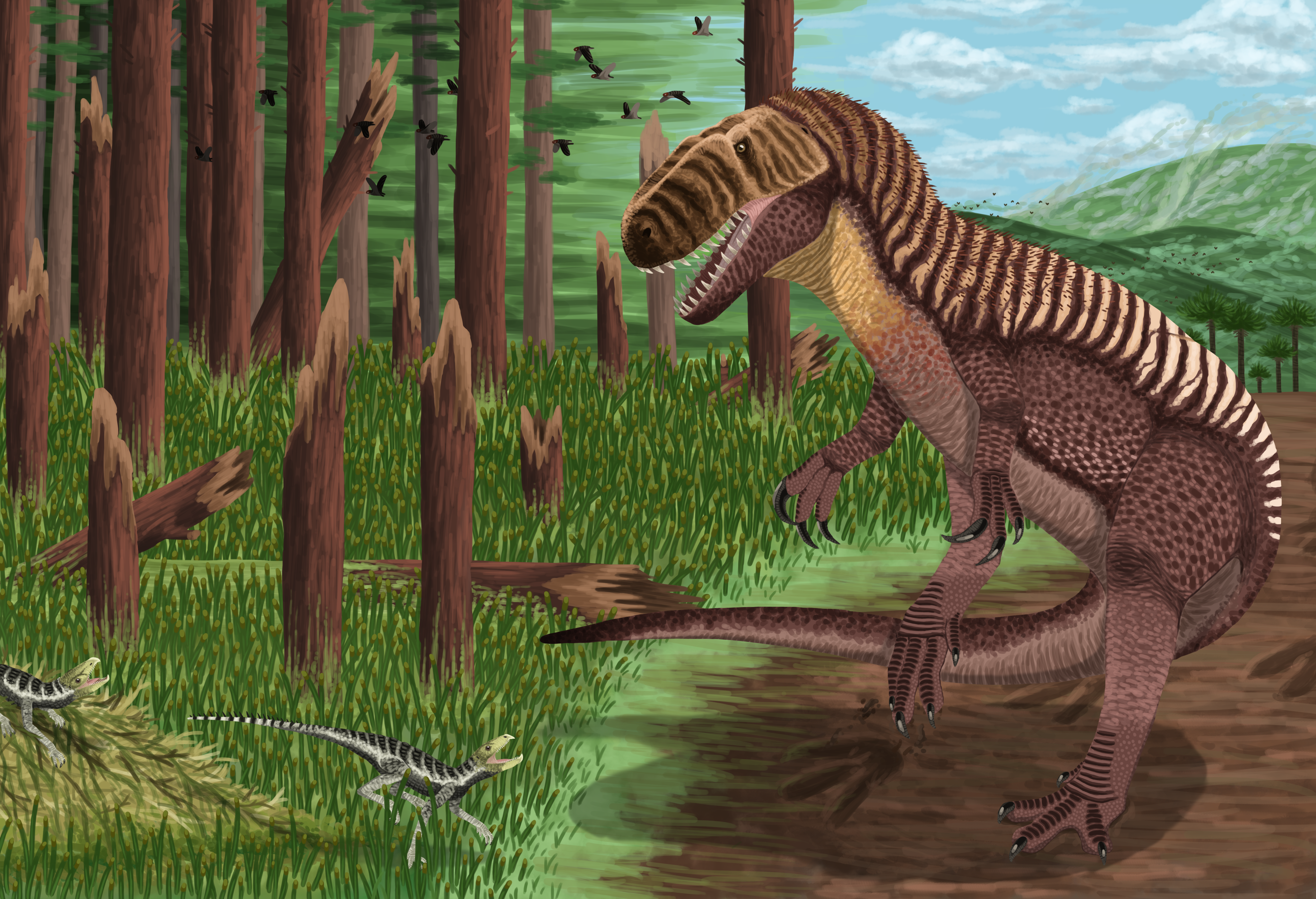HOME | DD
 TrollMans — Two Against One
TrollMans — Two Against One

Published: 2018-06-07 02:58:57 +0000 UTC; Views: 13487; Favourites: 281; Downloads: 32
Redirect to original
Description
A sub-adult Torvosaurus walking along the edge of a conifer forest makes a grave mistake when he unwittingly wanders too close to the nest of a pair of Macelognathus, which quickly rush to the defence of their eggs. He'll be lucky to escape from this blunder with his life.
---
Mid Tithonian (150 MYA), Colorado
Torvosaurus tanneri (Tanner’s savage lizard)- a species of megalosaurid theropod known from the Tithonian of Wyoming, Colorado, and Utah. A robustly built carnivore, T. tanneri is one of the largest predators known from the Morrison Formation, reaching ten metres in length and possibly over three tonnes in weight, larger than the contemporary Allosaurus fragilis and Ceratosaurus nasicornis (although both Ceratosaurus and Torvosaurus were seemingly much rarer than Allosaurus). Based on distribution of fossil remains, T. tanneri seems to have preferred wetter and more well forested regions, seemingly a common habitat preference among megalosaurids, however, the niche partitioning of Morrison Formation predators is still poorly understood. Another species of Torvosaurus is known from Portugal, T. gurneyi, which reached similar proportions to its North American relative, and it too coexisted with European species of Allosaurus and Ceratosaurus (among others). Just can’t seem to get away from them. Despite their apparent success, megalosaurids didn’t seem to survive past the end of the Jurassic.
Macelognathus vagans (wandering spade jaw)- a species of primitive crocodylomorph known from the Kimmeridgian to Tithonian of Wyoming and Colorado. A long-legged, gracile animal reaching about four feet in length, Macelognathus was not very large but makes up for this fact by having a hugely muddled taxonomic history and mysterious lifestyle. Originally described as a turtle, the tip of the lower mandible lacks teeth and its rugose surface texture suggest that a bird or turtle-like beak may have been present in life (the upper jaw tip is unknown so we don’t know if it had an upper beak to match, as depicted here, or something else entirely). It also has unusually shaped teeth, which along with this possible beak suggest it was eating something unusual, perhaps even plants, although the fragmentary nature of its remains makes these conclusions largely speculation. Adding to the mess is an apparent close relative also from the Morrison Formation, Hallopus victor (winner jumping foot [yes, a noun species name for some reason...]), which is extremely similar (and also not classified initially as a crocodyliform, but as a dinosaur), although smaller, and is very possibly synonymous with Macelognathus. In the case this is proven true, Hallopus would take priority and Macelognathus would be the adult form.
Mesadactylus ornithosphyos (bird loined Mesa finger)- a species of probable anurognathid pterosaur known from the Kimmeridgian to Tithonian of Colorado. The smallest known pterosaur from the Morrison Formation, with a hypothesized wingspan of seventy centimetres, however, the holotype synsacrum is the only definite remain that can be assigned to the species, the unusually bird-like construction of which gives the species its name (the fossil was in fact originally considered that of a bird). Although fossils indicate pterosaurs were likely plentiful and diverse in the Morrison Formation, they are always poorly preserved and fragmented, and Mesadactylus was no exception. Because the animal is known only from a few vertebrae in reality, here Mesadactylus is reconstructed as a generic anurognathid used as background filler and there’s not really much else I can say about them that wouldn’t be baseless speculation.
---
Sometimes large animals can be frightened off by much smaller animals, and sometimes smaller animals will attack much larger ones (I'm pretty sure one of the requirements of being a mustelid is the ability to fight and/or kill things twice your size or more for example). Also considered having Macelognathus as a small dinosaur species but decided to make things more difficult for myself by choosing an obscure, poorly known non-dinosaur in a formation filled with better, more well-known choices.
Ignore incredibly lazy forest background, please thanks.
Related content
Comments: 17

👍: 0 ⏩: 0

👍: 0 ⏩: 0

👍: 0 ⏩: 0

👍: 0 ⏩: 0

👍: 0 ⏩: 0

👍: 1 ⏩: 0

👍: 0 ⏩: 0

I'm sorry I don't understand, how are the Macelognathus a threat to the Torvosaurus?
👍: 0 ⏩: 2

they're calling him a nerd
👍: 0 ⏩: 0

They're not really, but it's based on small animals able to scare off bigger ones when they need to (the "fight" of fight or flight), like how you're supposed to make yourself look big and threatening if you encounter a bear, because the bigger animal will be suspicious of a prey animal that isn't fearful of them ("maybe small animal has some secret defence?? can't risk injury to find out."). Like a honey badger scaring off a lion, a goose chasing away a gorilla, a crow harassing an eagle, or a rat attacking a cat.
The description's just a joke though... mostly.
👍: 0 ⏩: 0

Well thanks for introducing me to Macelognathus. Seems like a rather interesting little critter.
👍: 0 ⏩: 0

Cool! Just out of curiosity, where did you get the information on the dinosaurs?
👍: 0 ⏩: 1

Mostly various sources on the internet, any website, open access scientific papers, and uploaded printed documents that are seemingly reliable. A lot of wikipedia is used (sourced info only of course), but for some more obscure animals I have to look more thoroughly (such as in this case, Macelognathus). Then I compile the important bits in a little summary.
Finding accessible information on barely known prehistoric organisms that is seemingly thought to be correct can get real difficult though.
👍: 0 ⏩: 1

Lol, I'll bet. Thank you for replying, I was just curious and I did some browsing last night on dinosaurs before I went to bed. I was never really into them but I think I just might get into them cause I'm playing Ark, lol. Keep up the very good work!
👍: 0 ⏩: 0




























